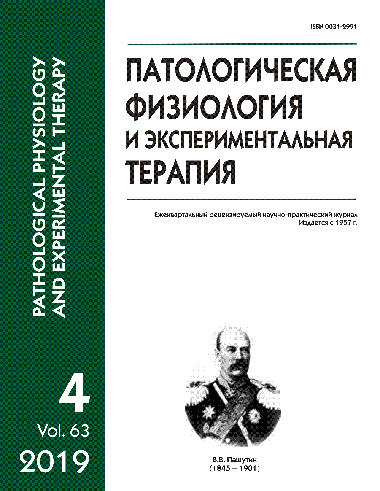Effect of free radical oxidation and content of corticosteroid receptors in lungs of animals with different sensitivity to hypoxia in the postresuscitation period
Abstract
Aim. The aim of the study was to characterize changes in free radical oxidation and corticosteroid receptor density in the lungs of animals with different sensitivity to hypoxia in the postresuscitation period. Methods. Experiments were performed on mongrel male white rats divided into two groups based on their hypoxia resistance, non-resistant and highly resistant. One week after testing the rats for resistance to hypoxia, a 5-min arrest of systemic circulation was modeled under ether anesthesia by intrathoracic compression of the vascular bundle of the heart with subsequent resuscitation. The follow-up period was 35 days. At 1, 3, 5, 7, 14, 21, and 35 days, the animals were sacrificed by decapitation under ether anesthesia, and blood and tissue samples were collected. Concentrations of corticosterone and aldosterone were measured in plasma; concentrations of glucocorticoid and mineralocorticoid receptors, thiobarbituric acid reactive substances, and carbonylated proteins, iron-dependent formation of dityrosine, activities of superoxide dismutase and catalase, and concentration of reduced glutathione were measured in lung homogenates. Results. Hypoxia non-resistant rats had a high intensity of free radical oxidation as evident from the development of carbonyl stress associated with decreased activities of key antioxidants and pronounced changes in the dynamics of corticosteroid receptors. A reduced level of corticosteroid receptors was observed in the first three days of resuscitation period and followed by a significant increase in mineralocorticoid receptors at the end of 35-day monitoring. High resistance to hypoxia was characterized by a relatively low intensity of free radical oxidation, evident only from increased lipid peroxidation, due to an adequate capacity and preservation of water-soluble antioxidants. During the early recovery period, high resistance to hypoxia was associated with preserved level of corticosteroid receptors whereas during late recovery, the high hypoxia resistance was associated with a significant increase in the concentration of glucocorticoid receptors. Conclusion. The increased density of glucocorticoid receptors in hypoxia high-resistant animals during the late recovery period (days 14-35) plays an important role, presumably by modulating the inflammatory process and restricting uncontrolled immune responses and tissue damage. The significant increase in mineralocorticoid receptors in hypoxia low-resistance animals may result in stimulation of vascular remodeling and development of pulmonary fibrosis.






